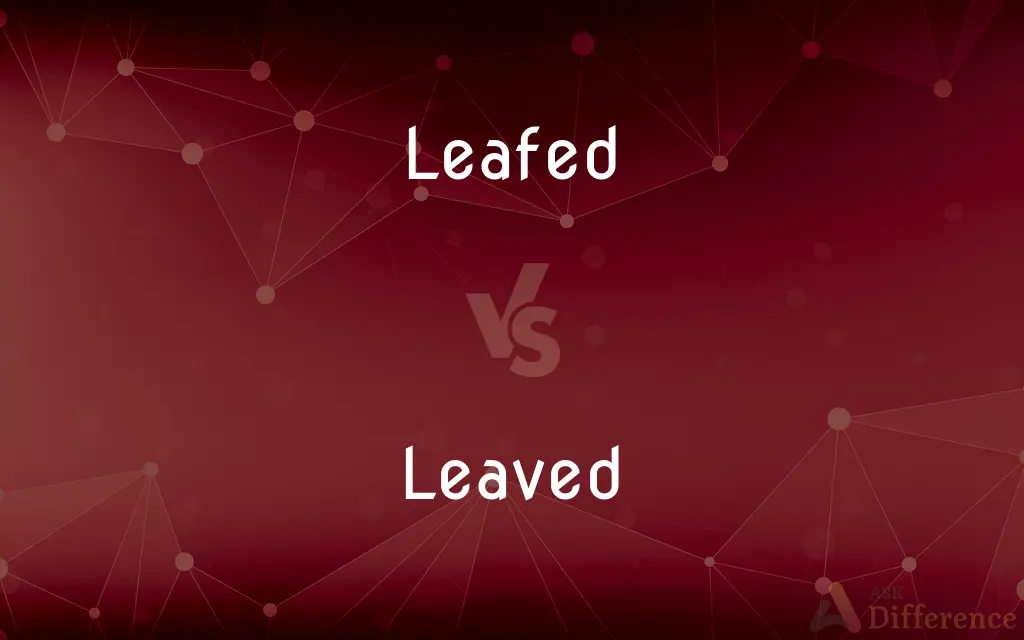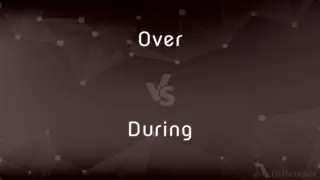Leafed vs. Leaved — What's the Difference?
Edited by Tayyaba Rehman — By Maham Liaqat — Updated on April 5, 2024
"Leafed" refers to something having leaves or the process of developing leaves, while "leaved" specifically describes the type or number of leaves.

Difference Between Leafed and Leaved
Table of Contents
ADVERTISEMENT
Key Differences
"Leafed" is often used to describe plants or trees that have developed leaves or the action of producing leaves, emphasizing the presence or emergence of foliage. It highlights the condition or state of having leaves, particularly after a period of growth or in a specific season. On the other hand, "leaved" is typically used as an adjective in compound forms, such as "broad-leaved" or "multi-leaved," to describe the characteristics of the leaves themselves, including their type, shape, or number.
When discussing gardening or botany, "leafed" can be used to talk about the stage of growth a plant is in, such as "newly leafed" trees in spring. This term captures the dynamic process of leaf development. Whereas "leaved" is used more statically, to classify plants based on their leaf traits, aiding in identification and understanding of plant varieties based on their leaf morphology.
In literature or more poetic uses, "leafed" might be employed to evoke imagery or describe scenes where the focus is on the presence of leaves and the life they signify, perhaps in changing seasons. "Leaved," however, would be used more meticulously to detail the specific attributes of the leaves, contributing to a deeper description or analysis of the scene or object being described.
"Leafed" could also relate to actions beyond botany, metaphorically implying something is covered or filled with leaves, like "leafed through a book," suggesting a quick browsing. "Leaved," in contrast, rarely steps outside its botanical context, maintaining a focus on describing physical leaf characteristics without venturing into metaphorical applications.
"Leafed" implies an action or state that can change over time, reflecting the natural cycle of plants losing and regaining leaves. "Leaved" describes more permanent features that typically do not change throughout the life of the plant, providing a consistent basis for botanical classification and identification.
ADVERTISEMENT
Comparison Chart
Definition
Referring to having leaves or developing leaves
Describing the type or number of leaves
Context
Growth, presence of leaves
Botanical classification, leaf characteristics
Usage
General, dynamic
Specific, static
Example Usage
"The garden is fully leafed in summer."
"This is a broad-leaved plant."
Non-botanical Use
Metaphorical, e.g., "leafed through a book"
Rarely used outside botanical context
Compare with Definitions
Leafed
The process of growing leaves.
By April, the bushes had fully leafed.
Leaved
Referring to the number of leaves.
This plant is classified as four-leaved.
Leafed
Having leaves.
The tree has finally leafed after a long winter.
Leaved
Describing leaf characteristics.
The newly discovered species is finely leaved.
Leafed
Browsing quickly.
He leafed through the magazine without much interest.
Leaved
Classification based on leaf type.
Broad-leaved forests dominate the landscape.
Leafed
Covered with leaves.
The forest floor was leafed with autumn colors.
Leaved
Indicating leaf shape.
Long-leaved plants thrive in this wet environment.
Leafed
Simple past tense and past participle of leaf
Leaved
Mentioning leaf arrangement.
The garden features uniquely patterned leaved specimens.
Leafed
Having a leaf or leaves (of the specified kind).
Leaved
Having a leaf or leaves of a particular kind
Ivy-leaved toadflax
Leafed
Having (such) a leaf or (so many) leaves; - used in composition; as, broad-leafed; four-leafed.
Leaved
Having or bearing a leaf or leaves.
Leafed
Having leaves or leaves as specified; often used in combination;
A fully leafed tree
Broad-leafed
Four-leaved clover
Leaved
Having a specified number or kind of leaves. Often used in combination
Three-leaved.
Wide-leaved.
Leaved
Having a leaf, leaves or folds
Leaved
Simple past tense and past participle of leave(in the sense "to produce leaves or foliage")
Leaved
Bearing, or having, a leaf or leaves; having folds; - used in combination; as, a four-leaved clover; a two-leaved gate; long-leaved.
Leaved
Having leaves or leaves as specified; often used in combination;
A fully leafed tree
Broad-leafed
Four-leaved clover
Common Curiosities
Can "leafed" refer to artificial objects?
Yes, metaphorically, it can describe something covered or filled, not limited to natural foliage.
Is "leafed" used only in spring?
While commonly associated with spring, "leafed" can refer to any period when plants develop or have leaves.
How does "leaved" help in plant identification?
"Leaved" provides specific details about leaf type, shape, or number, crucial for accurate plant identification.
Can "leaved" be used to describe any plant?
Generally, yes, as long as the description pertains to the plant's leaves.
What does "finely leaved" mean?
It refers to plants with small, delicate leaves.
Can a plant be both leafed and leaved?
Yes, a plant can be described as "leafed" in the context of having leaves and "leaved" in terms of specific leaf characteristics.
Why is "leaved" important in botany?
It allows for precise descriptions and classifications based on leaf characteristics.
What does "broad-leaved" mean?
It describes plants with wide leaves, as opposed to narrow or needle-like leaves.
Does "leafed" imply a temporary state?
Yes, it often signifies a condition that changes with seasons, reflecting the growth cycle of plants.
Is "leafed through" always literal?
No, it's often used metaphorically to mean browsing quickly through anything, like a book.
Can "leaved" describe the color of leaves?
While not typical, it can be part of a compound adjective that includes color, like "green-leaved."
How do "leafed" and "leaved" contribute to descriptive writing?
"Leafed" adds a dynamic quality, suggesting growth or presence, while "leaved" offers specific visual details.
What does "multi-leaved" indicate?
It describes plants with several leaves, often used in botanical or horticultural contexts.
Does "leafed" have any scientific implications?
It's more commonly used in general language rather than with precise scientific meaning.
How do the terms "leafed" and "leaved" reflect the life cycle of plants?
"Leafed" reflects the dynamic aspect of growth and seasonality, while "leaved" indicates more static, identifiable characteristics.
Share Your Discovery

Previous Comparison
Gymnastic vs. Gymnastics
Next Comparison
Over vs. DuringAuthor Spotlight
Written by
Maham LiaqatEdited by
Tayyaba RehmanTayyaba Rehman is a distinguished writer, currently serving as a primary contributor to askdifference.com. As a researcher in semantics and etymology, Tayyaba's passion for the complexity of languages and their distinctions has found a perfect home on the platform. Tayyaba delves into the intricacies of language, distinguishing between commonly confused words and phrases, thereby providing clarity for readers worldwide.
















































